 RICK HALL the so called expert on the West last night said that Sergio Leone's film THE GOOD BAD AND UGLY was wrong as nothing happened in Texas as regards the civil war, wrong.There were not great battles but battles happened.
RICK HALL the so called expert on the West last night said that Sergio Leone's film THE GOOD BAD AND UGLY was wrong as nothing happened in Texas as regards the civil war, wrong.There were not great battles but battles happened.
Tthe Union mounted several attempts to capture the Trans-Mississippi regions of Texas and Louisiana from 1862 until the war's end. With ports to the east under blockade or captured, Texas in particular became a blockade-running haven. Referred to as the "back door" of the Confederacy, Texas and western Louisiana continued to provide cotton crops that were transferred overland to the Mexican border town of Matamoros, Tamaulipas,
 and shipped to Europe in exchange for supplies. Determined to close this trade, the Union mounted several attacks, (below Foundry)each of them unsuccessful.
and shipped to Europe in exchange for supplies. Determined to close this trade, the Union mounted several attacks, (below Foundry)each of them unsuccessful.
The U.S. Navy blockaded the principal seaport, Galveston, for four years, and Federal infantry occupied the city for three months in late 1862. Confederate troops under Gen. John B. Magruder recaptured the city on January 1, 1863 and it remained in Confederate hands until the end of the war.
The Battle of Galveston or the Second Battle of Galveston was a naval and land battle that occurred on January 1, 1863, during the American Civil War when Confederate forces under Maj. Gen. John B. Magruder attacked and expelled occupyingUnion troops from the city of Galveston, Texas.
The First Battle of Galveston was a naval engagement fought on October 4, 1862, during early Union attempts to blockade Galveston Harbor.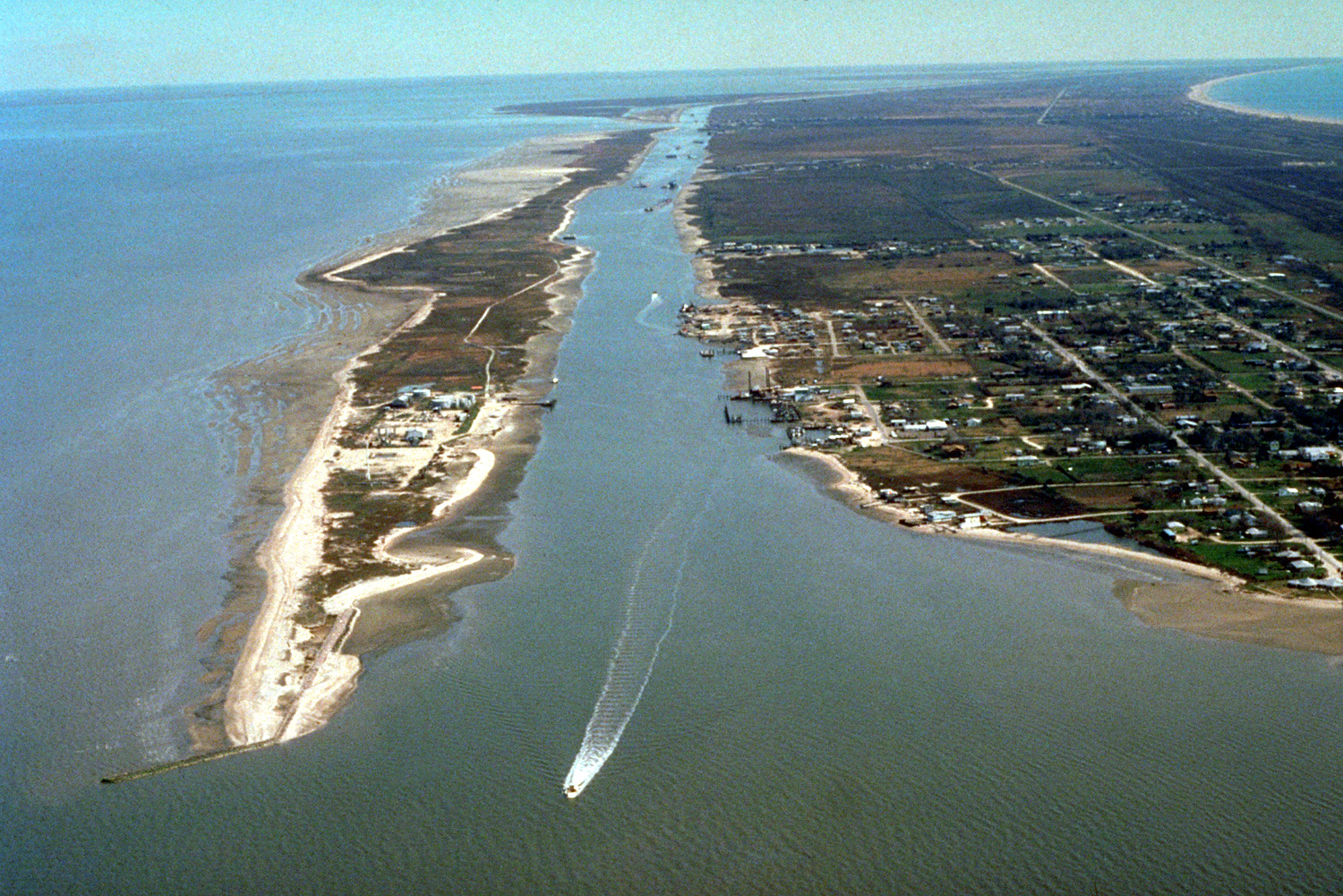 A few days later the Confederate raider CSS Alabama attacked and sunk the USS Hatteras in a naval engagement off the coast of Galveston.
A few days later the Confederate raider CSS Alabama attacked and sunk the USS Hatteras in a naval engagement off the coast of Galveston.
The Battle of Galveston or the Second Battle of Galveston was a naval and land battle that occurred on January 1, 1863, during the American Civil War when Confederate forces under Maj. Gen. John B. Magruder attacked and expelled occupyingUnion troops from the city of Galveston, Texas.
The First Battle of Galveston was a naval engagement fought on October 4, 1862, during early Union attempts to blockade Galveston Harbor.
 A few days later the Confederate raider CSS Alabama attacked and sunk the USS Hatteras in a naval engagement off the coast of Galveston.
A few days later the Confederate raider CSS Alabama attacked and sunk the USS Hatteras in a naval engagement off the coast of Galveston.
A few other cities also fell to Union troops at times during the war, including Port Lavaca(above and below),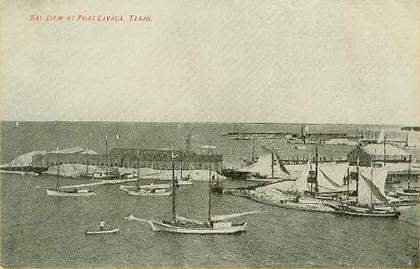 Indianola(below), and Brownsville. Federal attempts to seize control of Laredo, Corpus Christi, and Sabine Pass failed. By the end of the war no territory was in Union hands.
Indianola(below), and Brownsville. Federal attempts to seize control of Laredo, Corpus Christi, and Sabine Pass failed. By the end of the war no territory was in Union hands.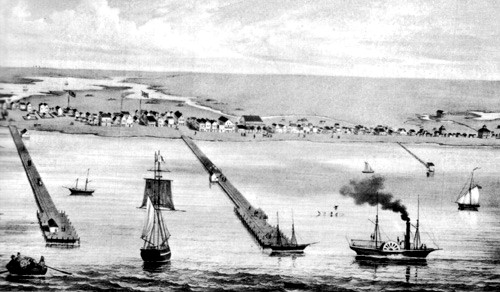
 Indianola(below), and Brownsville. Federal attempts to seize control of Laredo, Corpus Christi, and Sabine Pass failed. By the end of the war no territory was in Union hands.
Indianola(below), and Brownsville. Federal attempts to seize control of Laredo, Corpus Christi, and Sabine Pass failed. By the end of the war no territory was in Union hands.
The most notable military battle in Texas during the war happened on September 8, 1863. At the Battle of Sabine Pass, a small garrison of 46 Confederates from the mostly-Irish Davis Guards under Lt. Richard W. Dowling, 1st Texas Heavy Artillery, defeated a much larger Union force from New Orleans under Gen. William B. Franklin.
a small garrison of 46 Confederates from the mostly-Irish Davis Guards under Lt. Richard W. Dowling, 1st Texas Heavy Artillery, defeated a much larger Union force from New Orleans under Gen. William B. Franklin. 
Skilled gunnery by Dowling's troops disabled the lead ships in Franklin's flotilla, prompting the remainder—4,000 men on 27 ships—to retreat back to New Orleans. This victory against such overwhelming odds resulted in the Confederate Congress passing a special resolution of recognition and CSA President Jefferson Davis stating: "Sabine Pass will stand, perhaps for all time, as the greatest military victory in the history of the world."
 a small garrison of 46 Confederates from the mostly-Irish Davis Guards under Lt. Richard W. Dowling, 1st Texas Heavy Artillery, defeated a much larger Union force from New Orleans under Gen. William B. Franklin.
a small garrison of 46 Confederates from the mostly-Irish Davis Guards under Lt. Richard W. Dowling, 1st Texas Heavy Artillery, defeated a much larger Union force from New Orleans under Gen. William B. Franklin. Skilled gunnery by Dowling's troops disabled the lead ships in Franklin's flotilla, prompting the remainder—4,000 men on 27 ships—to retreat back to New Orleans. This victory against such overwhelming odds resulted in the Confederate Congress passing a special resolution of recognition and CSA President Jefferson Davis stating: "Sabine Pass will stand, perhaps for all time, as the greatest military victory in the history of the world."

In 1864, many Texas forces, including a division under French Prince Camille de (above)PolignacPolignac was born in Millemont Seine-et-Oise, France, into one of the most famous families of the French nobility. His grandmother, Gabrielle, had been a famous aristocratic beauty and Queen Marie-Antoinette's closest friend. His father was Jules, prince de Polignac, who had been a passionate supporter of absolute monarchy and chief minister during the reign of KingCharles X of France, who trusted him implicitly and shared his political sympathies. Through his distant cousin, Pierre de Polignac, he was related to the Grimaldis of Monaco, a family who still rule that principality today.
into one of the most famous families of the French nobility. His grandmother, Gabrielle, had been a famous aristocratic beauty and Queen Marie-Antoinette's closest friend. His father was Jules, prince de Polignac, who had been a passionate supporter of absolute monarchy and chief minister during the reign of KingCharles X of France, who trusted him implicitly and shared his political sympathies. Through his distant cousin, Pierre de Polignac, he was related to the Grimaldis of Monaco, a family who still rule that principality today.
 into one of the most famous families of the French nobility. His grandmother, Gabrielle, had been a famous aristocratic beauty and Queen Marie-Antoinette's closest friend. His father was Jules, prince de Polignac, who had been a passionate supporter of absolute monarchy and chief minister during the reign of KingCharles X of France, who trusted him implicitly and shared his political sympathies. Through his distant cousin, Pierre de Polignac, he was related to the Grimaldis of Monaco, a family who still rule that principality today.
into one of the most famous families of the French nobility. His grandmother, Gabrielle, had been a famous aristocratic beauty and Queen Marie-Antoinette's closest friend. His father was Jules, prince de Polignac, who had been a passionate supporter of absolute monarchy and chief minister during the reign of KingCharles X of France, who trusted him implicitly and shared his political sympathies. Through his distant cousin, Pierre de Polignac, he was related to the Grimaldis of Monaco, a family who still rule that principality today.
Polignac studied mathematics and music at St. Stanislas College in the 1840s. In 1853 he joined the French army. He served in the Crimean War from 1854 to 1855, receiving a commission as a second lieutenant. He resigned from the army in 1859 and traveled to Central America to study geography and political economy, as well as the native plant life. He then visited the United States in the early 1860s.) moved into Northwestern Louisiana to stall Union Maj. Gen. Nathaniel Banks' Red River Campaign, which was intended to advance into Texas from its eastern border. Confederate forces halted the expedition at the Battle of Mansfield, just east of the Texas border.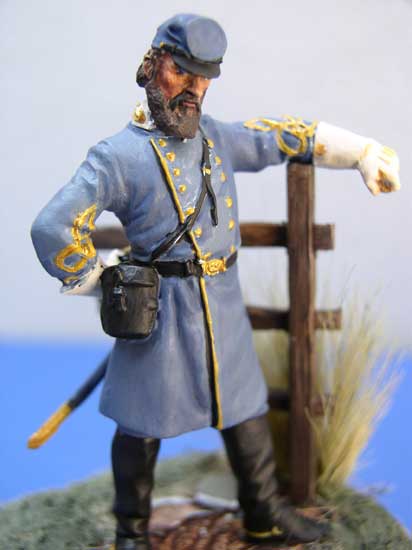

The last battle of the Civil War, the Battle of Palmito Ranch, was fought in Texas on May 12, 1865, well after Robert E. Lee's surrender on April 9, 1865, at Old Appomattox Court House,Virginia.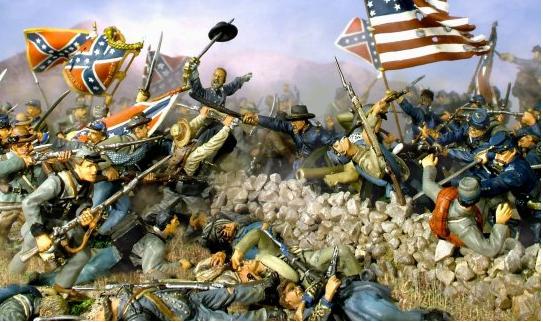

In the spring of 1865, Texas contained over 60,000 soldiers of the Army of the Trans-Mississippi under Gen. Edmund Kirby Smith. As garrison troops far removed from the main theaters of the war, morale had deteriorated to the point of frequent desertion and thievery. 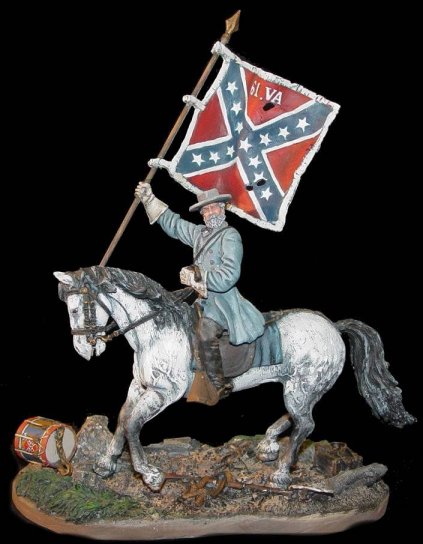 News of the surrender of Lee and other Confederate generals east of the Mississippi finally reached Texas around April 20. Local Confederate authorities had mixed opinions on their future course of action. Most senior military leaders vowed to press on with the war, including commanding general Kirby Smith. Many soldiers, however, greeted frequent speeches whose theme was "fight on, boys" with derision, or simply failed to attend them.
News of the surrender of Lee and other Confederate generals east of the Mississippi finally reached Texas around April 20. Local Confederate authorities had mixed opinions on their future course of action. Most senior military leaders vowed to press on with the war, including commanding general Kirby Smith. Many soldiers, however, greeted frequent speeches whose theme was "fight on, boys" with derision, or simply failed to attend them.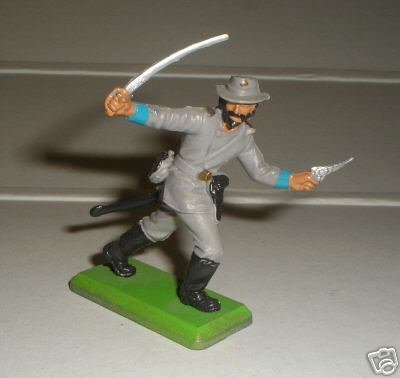
 News of the surrender of Lee and other Confederate generals east of the Mississippi finally reached Texas around April 20. Local Confederate authorities had mixed opinions on their future course of action. Most senior military leaders vowed to press on with the war, including commanding general Kirby Smith. Many soldiers, however, greeted frequent speeches whose theme was "fight on, boys" with derision, or simply failed to attend them.
News of the surrender of Lee and other Confederate generals east of the Mississippi finally reached Texas around April 20. Local Confederate authorities had mixed opinions on their future course of action. Most senior military leaders vowed to press on with the war, including commanding general Kirby Smith. Many soldiers, however, greeted frequent speeches whose theme was "fight on, boys" with derision, or simply failed to attend them.
The month of May brought increasing rates of desertion. News of Joseph E. Johnston's and Richard Taylor's surrenders confirmed that Texas, Louisiana, and Arkansas were now essentially alone to continue the Confederate cause.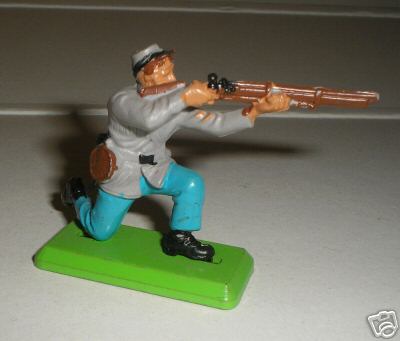 On May 14, troops in Galveston briefly mutinied, but were persuaded to remain under arms. However, morale continued to sink. Generals John B. Magruder and Kirby Smith (who had already corresponded with Union Maj. Gen. John Pope regarding surrender terms on May 9) no longer sought to rally their demoralized troops, but rather began discussing the distribution of Confederate government property. Magruder pled that the rapid disbanding of the army would prevent depradations by disgruntled soldiers against the civilian population
On May 14, troops in Galveston briefly mutinied, but were persuaded to remain under arms. However, morale continued to sink. Generals John B. Magruder and Kirby Smith (who had already corresponded with Union Maj. Gen. John Pope regarding surrender terms on May 9) no longer sought to rally their demoralized troops, but rather began discussing the distribution of Confederate government property. Magruder pled that the rapid disbanding of the army would prevent depradations by disgruntled soldiers against the civilian population
 On May 14, troops in Galveston briefly mutinied, but were persuaded to remain under arms. However, morale continued to sink. Generals John B. Magruder and Kirby Smith (who had already corresponded with Union Maj. Gen. John Pope regarding surrender terms on May 9) no longer sought to rally their demoralized troops, but rather began discussing the distribution of Confederate government property. Magruder pled that the rapid disbanding of the army would prevent depradations by disgruntled soldiers against the civilian population
On May 14, troops in Galveston briefly mutinied, but were persuaded to remain under arms. However, morale continued to sink. Generals John B. Magruder and Kirby Smith (who had already corresponded with Union Maj. Gen. John Pope regarding surrender terms on May 9) no longer sought to rally their demoralized troops, but rather began discussing the distribution of Confederate government property. Magruder pled that the rapid disbanding of the army would prevent depradations by disgruntled soldiers against the civilian population
The haste to disband the army, combined with the pressing need to protect Confederate property from Union confiscation, created general mayhem. Soldiers began openly pillaging the Galveston quartermasters stores on May 21.

Over the next few days, a mob demanded that a government warehouse be opened to them, and soldiers detained and plundered a train. Several hundred civilians sacked the blockade runner Lark when it docked on May 24, and troops sent to pacify the crowd soon joined in the plunder. On May 23, residents in Houston sacked the ordnance building and the clothing bureau. Riots continued in the city until May 26. Both government and private stores were raided extensively in Tyler, Marshall, Huntsville, Gonzales, Hempstead, La Grange, and Brownsville. In Navasota, a powder explosion cost eight lives and flattened twenty buildings. In Austin, the state treasury was raided and $17,000 in gold was stolen. By May 27, half of the original Confederate forces in Texas had deserted or been disbanded, and formal order had disappeared into lawlessness in many areas of Texas.(below 1st Texas )


Over the next few days, a mob demanded that a government warehouse be opened to them, and soldiers detained and plundered a train. Several hundred civilians sacked the blockade runner Lark when it docked on May 24, and troops sent to pacify the crowd soon joined in the plunder. On May 23, residents in Houston sacked the ordnance building and the clothing bureau. Riots continued in the city until May 26. Both government and private stores were raided extensively in Tyler, Marshall, Huntsville, Gonzales, Hempstead, La Grange, and Brownsville. In Navasota, a powder explosion cost eight lives and flattened twenty buildings. In Austin, the state treasury was raided and $17,000 in gold was stolen. By May 27, half of the original Confederate forces in Texas had deserted or been disbanded, and formal order had disappeared into lawlessness in many areas of Texas.(below 1st Texas )

The formal remnants of Kirby Smith's army had finally disintegrated by the end of May. Upon his arrival in Houston from Shreveport , the general called a court of inquiry to investigate the "causes and manner of the disbandment of the troops in the District of Texas, New Mexico and Arizona." The May 30 findings laid the blame primarily on the civilian population. Kirby Smith addressed his few remaining soldiers and condemned those that had fled for not struggling to the last and leaving him "a commander without an army– a General without troops." On June 2, he formally surrendered what was left of the Army of the Trans-Mississippi.
, the general called a court of inquiry to investigate the "causes and manner of the disbandment of the troops in the District of Texas, New Mexico and Arizona." The May 30 findings laid the blame primarily on the civilian population. Kirby Smith addressed his few remaining soldiers and condemned those that had fled for not struggling to the last and leaving him "a commander without an army– a General without troops." On June 2, he formally surrendered what was left of the Army of the Trans-Mississippi.

 , the general called a court of inquiry to investigate the "causes and manner of the disbandment of the troops in the District of Texas, New Mexico and Arizona." The May 30 findings laid the blame primarily on the civilian population. Kirby Smith addressed his few remaining soldiers and condemned those that had fled for not struggling to the last and leaving him "a commander without an army– a General without troops." On June 2, he formally surrendered what was left of the Army of the Trans-Mississippi.
, the general called a court of inquiry to investigate the "causes and manner of the disbandment of the troops in the District of Texas, New Mexico and Arizona." The May 30 findings laid the blame primarily on the civilian population. Kirby Smith addressed his few remaining soldiers and condemned those that had fled for not struggling to the last and leaving him "a commander without an army– a General without troops." On June 2, he formally surrendered what was left of the Army of the Trans-Mississippi.
Federal troops did not arrive in Texas to restore order until June 19, 1865, when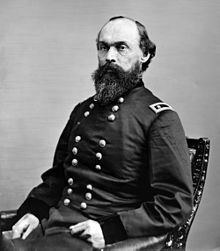 Union Maj. Gen. Gordon Granger and 2,000 Union soldiers arrived on Galveston Island
Union Maj. Gen. Gordon Granger and 2,000 Union soldiers arrived on Galveston Island to take possession of the state and enforce slaves’ new freedoms.
to take possession of the state and enforce slaves’ new freedoms.
The Texas holiday Juneteenth commemorates this date. The Stars and Stripes were not raised over Austin until June 25.

 Union Maj. Gen. Gordon Granger and 2,000 Union soldiers arrived on Galveston Island
Union Maj. Gen. Gordon Granger and 2,000 Union soldiers arrived on Galveston Island to take possession of the state and enforce slaves’ new freedoms.
to take possession of the state and enforce slaves’ new freedoms.The Texas holiday Juneteenth commemorates this date. The Stars and Stripes were not raised over Austin until June 25.

President Andrew Johnson appointed Union General Andrew J. Hamilton, a prominent politician before the war, as the provisional governor on June 17. He granted amnesty to ex-Confederates if they promised to support the Union in the future, appointing some to office. However, it was not until March 30, 1870, that the United States Congress permitted Texas' representatives to take their seat in Congress, although Texas did not meet all the formal requirements for readmission.


No comments:
Post a Comment